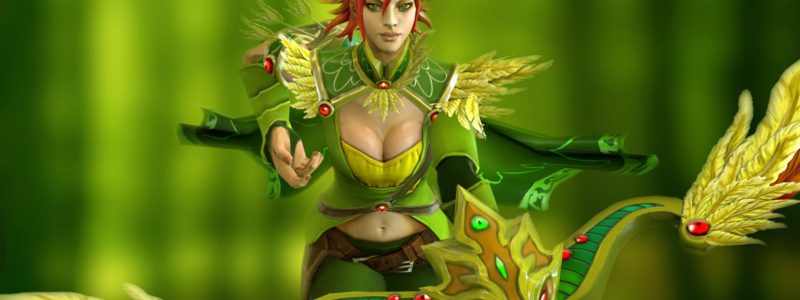I wrote the text below on dev.dota2.com forums initially but posted it here as well.
Understanding on balance
Today, 10:59 AM
In game theory there are two terms called
"Dominated strategy" – At least one other strategy is always better.
"Dominating strategy" – At least one other strategy is always worse.
Using set theoretic notation these strategies can be described as a list of element surrounded by curly brackets {}, and each strategy could be denoted as lowercase s with a subscript for index number. E.g. { s1, s2, s3 }. The strategies in this jargon are analogous to player choice. You have 3 choices. Your opponent(s) also have a similar set of strategies. If it would be that s3 always yields a better value than s2 then s3 is a dominating strategy, and s2 is a dominated strategy. Dominating strategy can also be used when s3 is always better than all other strategies.
Introducing this jargon probably doesn't serve a real purpose as it takes more time to explain it than you can save by using it but I wanted to do it anyway.
Balancing is something different, but some aspects of balance are related to the above concepts.
"Balance" in DOTA2 or some other game seems to be mostly about preserving the meaningfulness of each character and item, such that they have some sort of niche utility they can serve, even if they're not always useful, there is at least one circumstance where they can be useful.
In the terms of "dominated strategy" or "dominating strategy", you would want to avoid situations where hero A > B regardless of what the opposing team does. This can arise when two heroes are too similar, and one ends up doing the same thing "just better" than the other, instead of different. In the context of items this can mean that you should always get some item, regardless of what everyone else is doing.
Balance has relational properties
For an example the usefulness of Eye of Skadi is proportional to that how many players in the opposing team have purchased Heart of Tarrasque. That is there is an interaction between the usefulness of these two choices of players on opposing sides.
I. Introducing counter strategies
One tool in the toolkit for "balancing" can be not changing the thing at hand, but changing something else instead. For an example, using the above example, if Heart of Tarrasque was somehow "too useful", you might not need make it less useful, you could also introduce an item that makes it weaker or improve one of the items that already counter it. E.g. "HoT too good!" -> "Eye of Skadi regen reduction increase".
The main idea is to make the game meaningful and interesting. Sometimes it's easier to achieve that not by thinking only in terms of "strengthening" and "weakening" , or "buffing" and "nerfing", but also doing this on the relational level like "synergizing" and "countering".
Using this jargon of strategies, like the set of player 1's strategies { s1, s2, s3 } and player 2's strategies { s4, s5, s6 }, and if the issue is player1's strategy s2 was too useful, you could look at how to make some of { s4, s5, s6 }, better given player 1 has chosen s2.
II. Differentiating similar things from each other
One such source of dominated strategies and dominating strategies in competitive games is lack of meaningful dissimilarity. E.g. you have have a thing A that does Y, and another thing B that does Y but twice better, it can result to a situation where B overlaps and dominates A to such an extent A has no function or niche in the game anymore.
DOTA's items have a pronounced character, which means implicitly they must be different from one another, and that in turn solves some of these balance question implicitly as well.
In addition the item recipe system counters these balance issues to some extent. E.g. if Blades of attack costs 450g and gives +9 damage, and Claymore costs 1350g and gives +20, one might claim that Claymore is a pointless item, because Claymore has a lower cost efficiency ratio. In DOTA though this does not happen for several reasons, but the main reason being that you can make different items by using them as components. There's also questions about slot intensity versus cost efficiency, and by looking some excel tables, it's also clear that some thought has been put into these things.
For the sake of example, if it somehow was that these two items were too similar, like broadsword and claymore which cost almost the same, and have a similar cost efficiency ratio, you might want to look at how to make the different from each other to avoid the situation where one item is just better than the other, because they're doing the very same thing. Which could be an actual issue, if not for the recipe system, and the slot intensity considerations. and some other factors.
III. Hero winrate perspectives
By default most heroes should have approximately 50.00% winning rate, but that's not the only way to look at these values, it does seem like the only correct baseline. For an example if Hero A has win rate 55.00%, and hero B has winrate 45.00%, but when both hero A and hero B are in the same match on opposing sides, if hero B then has a higher win rate than hero A, you could say they counter each other, and that gives hero B at least one niche, meaning it's not always a bad choice/strategy, but dependent on the strategy of the opposing team, and at the same time, this interaction ensures that hero A is not always winning because of the same interaction.
So if some hero is too strong, you don't necessarily need to make it weaker, you can also look at how other heroes counter that hero, and improve how they do that.
So this section is really about assessing the current balance by looking at:
– How the winrates of heroes interact with each other to determine if some heroes is always good or if some hero is always bad choice.
– If there is a pair of heroes such that A is always better than B regardless of the heroes in the opposing team
Here is the link for the original post:
Source: https://www.reddit.com/r/DotA2/comments/ppjova/on_understanding_balance/







